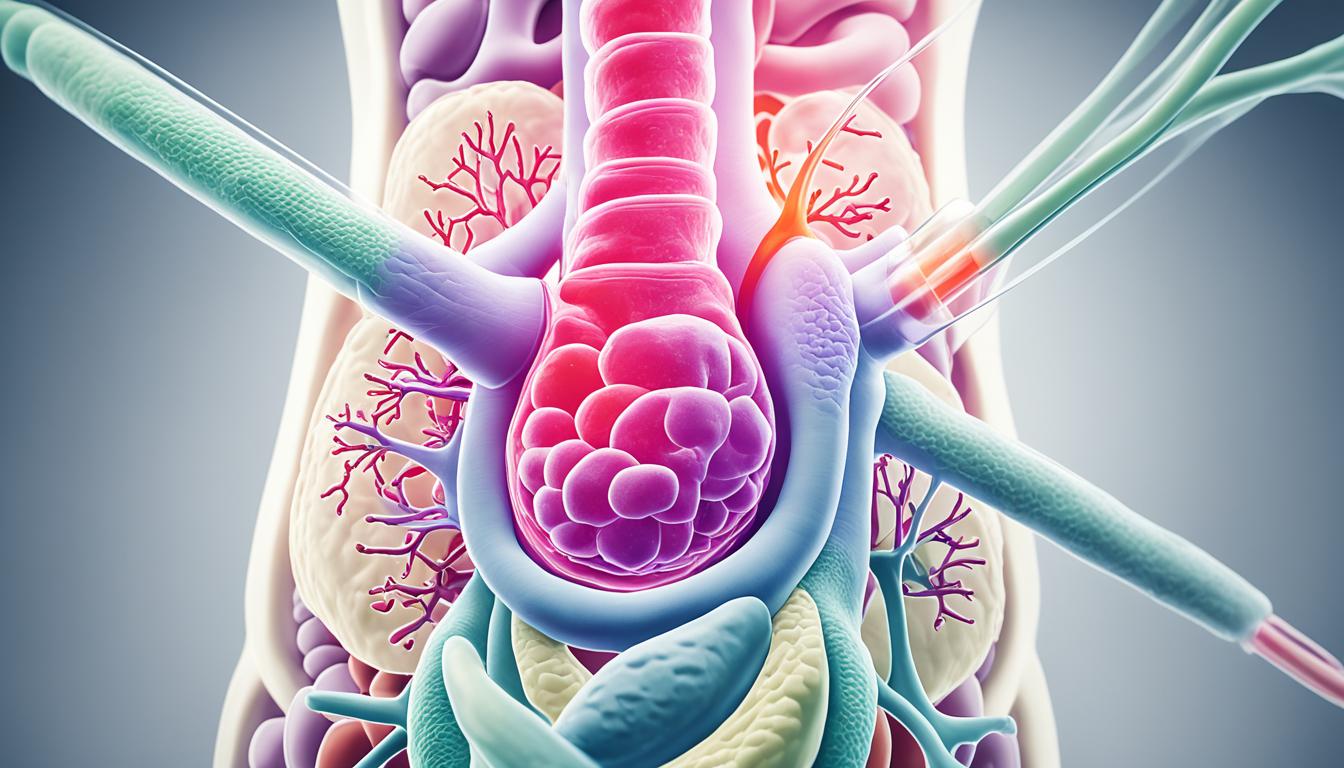Intestinal lipodystrophy is a rare condition that changes how fat is spread in the body. It affects the digestive system, making it hard for the body to absorb fats properly. This leads to bloating, diarrhea, malnutrition, and stomach pain. Researchers believe it’s linked to how the body processes fats and absorbs them.
Diagnosing it can be complex. Doctors look at the patient’s history, do a checkup, and might do genetic tests. Finding certain gene changes can greatly help in managing and treating intestinal lipodystrophy.
There’s not many treatment options yet. But, stem cell therapy is showing some exciting potential. This type of treatment aims to use stem cells to fix the damage to the intestine. By doing so, it may be able to help the body better absorb nutrients.
Key Takeaways:
- Intestinal lipodystrophy is pretty rare and affects how fats are spread in the body.
- It’s thought to come from issues with fat metabolism and how the body takes in fats.
- It can cause stuff like stomach pain, bloating, diarrhea, and not getting enough nutrients.
- Figuring out if someone has it includes learning about their health, exams, and genetic tests.
- Stem cell therapy might be a new route for treating intestinal lipodystrophy.
Symptoms of Intestinal Lipodystrophy
Intestinal lipodystrophy is a rare genetic condition. It affects how the body stores fat, leading to digestive symptoms. Some common signs include abdominal pain, diarrhea, bloating, and malnutrition.
These symptoms can change from one person to the next. So, if you have these signs, it’s important to see a doctor right away. A fast diagnosis and management help improve your life. Professionals will look at the root cause and offer the right treatment.
Causes and Diagnosis of Intestinal Lipodystrophy
Intestinal lipodystrophy is a rare genetic condition. It comes from changes in genes for fat processing. These changes lead to fat not being stored right in the body.
Doctors diagnose it with a deep look at your past and a genetic test. They also see if others in your family have the same genes. This helps them be sure about the diagnosis.
Genetic tests are very important for diagnosing intestinal lipodystrophy. These tests look for the specific gene changes that cause the disorder. Finding these changes is key to a clear diagnosis and correct treatment.
Genetic Testing for Intestinal Lipodystrophy
Genetic tests are essential to understand intestinal lipodystrophy. They check your genes to find out if any are not working well. These faulty genes can explain why someone has this rare disorder.
By finding these gene problems, doctors can plan better treatments. The genetic test also tells us more about the disease. This helps doctors and families make good decisions about care and family planning.
Genetic tests are not just for diagnosis. They are also important for family advice. They tell close relatives their risk of having children with the same condition. This helps families make choices about having kids.
Genes Associated with Intestinal Lipodystrophy
| Gene | Function | Associated Symptoms |
|---|---|---|
| AGPAT2 | Plays a role in lipid metabolism | Lipodystrophy, gastrointestinal symptoms |
| Berardinelli-Seip congenital lipodystrophy (BSCL2) | Involved in lipid droplet formation and adipocyte development | Lipodystrophy, insulin resistance, gastrointestinal symptoms |
| Caveolin 1 (CAV1) | Forms structural scaffolding in lipid rafts | Lipodystrophy, gastrointestinal symptoms, metabolic abnormalities |
Genetic tests are key to knowing intestinal lipodystrophy better. They help confirm its presence, guide treatment, and support family choices. By learning more about its genetics, doctors can give personalized care that helps patients live better.
Stem Cell Therapy for Intestinal Lipodystrophy
Intestinal lipodystrophy is a rare but serious genetic condition. It changes how fat is spread in the body. This leads to problems in the gut. Until now, there haven’t been many ways to treat it. But stem cell therapy might change that. It’s becoming a hopeful method in regenerative medicine for those with this condition.
So, what is stem cell therapy? It uses stem cells to fix damaged tissues. Stem cells can turn into different types of cells. This makes them a great choice for fixing the intestine’s normal work. Early signs are encouraging. Stem cell therapy could possibly make the gut work normally for people with intestinal lipodystrophy.
There’s still more to learn about using stem cell therapy for this condition. More studies and trials are needed. This way, we can be sure it’s safe and works well. The current research is a good start. But we need more to understand and make the treatment better.
In the end, the future looks bright with stem cell therapy for intestinal lipodystrophy. As experts learn more and the field of regenerative medicine grows, there’s real hope. This new method could bring better days for those affected by this rare disorder.
FAQ
Q: What are the symptoms of intestinal lipodystrophy?
A: Intestinal lipodystrophy can lead to abdominal pain and bloating. Diarrhea and malnutrition are also common. These symptoms may vary in how bad they are and how often they happen from person to person.
Q: What causes intestinal lipodystrophy and how is it diagnosed?
A: This condition is linked to rare genetic factors. Changes in certain genes seem to play a key role. They affect how the body uses and absorbs fats. Doctors diagnose it by looking at a person’s history, doing a physical exam, and genetic tests.
Q: Is there a treatment for intestinal lipodystrophy?
A: There are not many treatments, but stem cell therapy is showing hope. This therapy works by fixing the damaged parts of the intestine with the help of stem cells.
Q: How does stem cell therapy work for intestinal lipodystrophy?
A: Stem cells can turn into different cell types. They are great for growing back damaged tissues. Early studies indicate that this therapy might help restore the intestine’s normal function in people with intestinal lipodystrophy. More research and tests are necessary to be sure of its safety and results.

